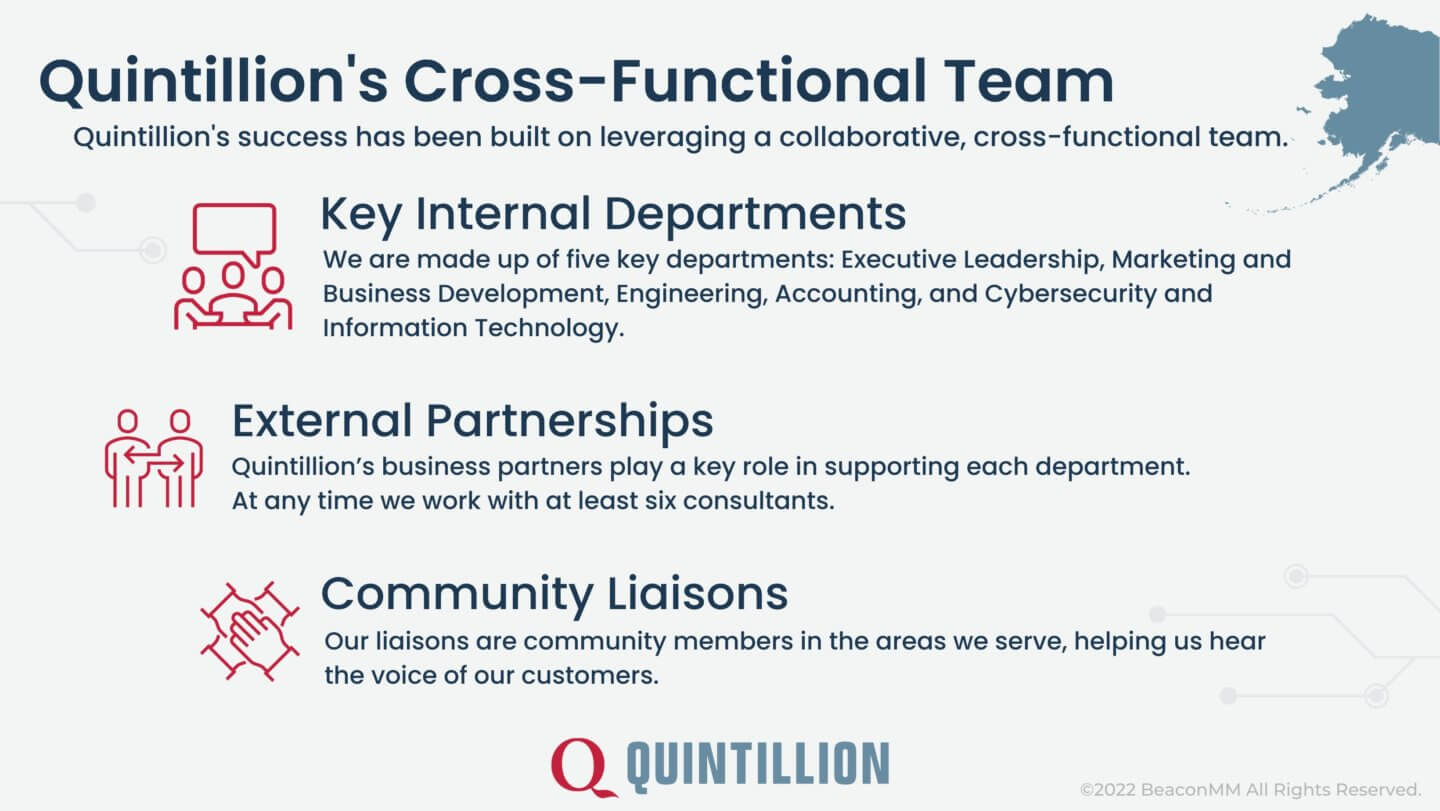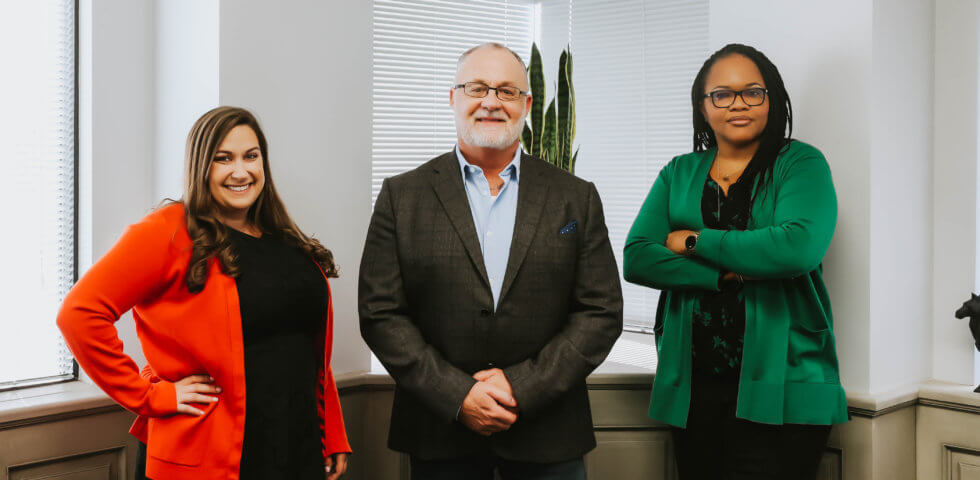In the past five years, Quintillion has achieved many monumental accomplishments. From building the North American Arctic’s first subsea and terrestrial fiber optic cable system to launching the highest-latitude satellite ground station in the United States, Quintillion has proudly strategized, developed, constructed, and launched several major projects that have made a significant impact on the lives of Alaskans, the satellite industry, and the military.
While each of these projects required great construction and engineering expertise, we know that none of these achievements would have been possible without Quintillion’s team of SMEs spearheading each project. For this blog, we interviewed Adaweze (Ada) Maduakor, Quintillion’s Market Development Manager, to get a behind-the-scenes look at who makes up Quintillion’s team, as well as how they work together to bridge the digital divide, both locally and globally.
Who Makes Up Quintillion’s Cross Functional Team?

Quintillion is a small team made up of five key departments: Executive Leadership, Marketing and Business Development, Engineering, Accounting, and Cybersecurity and Information Technology. The Marketing and Business Development group, headed by Quintillion’s President Mac McHale, is one of the main departments that engages with all of the other departments. This department plays a key role in developing Quintillion’s brand, performing customer and community outreach, developing marketing and business strategies, managing Quintillion’s portfolio, and handling revenue strategy.
Meanwhile, the Engineering group is responsible for the construction and maintenance of our infrastructure, while our Accounting group oversees Quintillion’s financial reporting, contract management, budgeting, and risk management. The final department, Cybersecurity and Information Technology, oversees both internal IT for Quintillion’s systems, as well as security and maintenance of customer-facing infrastructure, such as our resilient fiber optic cables, landing stations, and the High-Latitude Data Acquisition (HiLDA) ground station.
External Consultants and Partnerships
In addition to these five key groups that reside within the organization, Quintillion also has a team of external consultants we work with. Some of these consultants are constant, while others are employed on an at-need basis. At any given time, Quintillion is working with at least six different consultants.
This is a key difference that sets Quintillion apart. If we find that a critical subject matter expert does not exist within our team, we won’t hesitate to go out and engage external consultants. We will even bring on new people internally if the need presents itself. It is this ability that enables us to be resilient and flexible as we take on new projects.
Quintillion’s business partners also play a key role in supporting each department, including executing marketing strategies, engaging key players, completing construction projects, and building out the suite of services provided to customers. These partnerships often play a vital role in our overall strategy to bridge the digital divide, as it won’t take just one organization to resolve Alaska’s (or the world’s) connectivity gaps.
One example provided by Maduakor was Quintillion’s recent partnership with OneWeb, a leader in low earth orbiting satellite technology. “With our partnership with OneWeb, we know that satellite brings its own huge advantage. Of course, fiber optics is the gold standard, but we choose to partner with those organizations that will make our communities have the broadband services that are required and fill in gaps that fiber cannot yet reach. Our model is based on strategizing what works best for Alaska as a whole and expanding our global strategy to make Alaska the fulcrum of what is happening in the future.”
Community Engagement
Our liaisons are another group that is external to the organization but important for our mission of bridging the digital divide. These liaisons represent different communities that Quintillion works with, as we’re very mindful when it comes to hearing the voice of our customers. For us, this means physically going out into the communities where we work. By doing so, we’re able to actively bring community members who can give us insight into that community’s specific needs on board.
In the last month alone, Maduakor has visited four remote Alaskan communities. “We don’t want to build out a huge infrastructure and drop it on a community’s doorstep and say ‘Here you go. Look at what we did for you,’ without ever engaging and hearing from them what their needs and requirements are,” she commented when asked about Quintillion’s dedication to engaging with the communities it provides service to. “It’s a part of our organic internal process. We look for additional liaisons for every community we bring on board. We want to work hand in hand with them. Alaska is a huge place geographically. For you to engage the community where they’re at, you need to have a working relationship with a resident that lives there.”
She also explained the importance of outreach when it comes to engaging the communities they work with, saying, “We support a lot of initiatives in those communities. We look for events and initiatives we can support that bring economic growth and exposure to those communities.” Quintillion strives to support communities in many ways. This includes things such as supporting educational opportunities and sponsoring the Iron Dog race, a 2,500 mile+ snowmobile race that traverses from Big Lake to Nome and back again.
How Does Quintillion’s Team Promote Collaboration?
When combined, the experience of Quintillion’s team across the board, paired with each person’s level of expertise brought in from telecommunications, project management, accounting, and engineering, totals about 250 years.
Our collaboration and strong team dynamics are key to our success as a company. The personal collaboration styles and behaviors of each individual come into play when we work. When looking to accomplish big goals, everyone is aware of the overall strategy, and therefore privy to their role when it comes to the project.
That said, the construction of the HiLDA ground station in the middle of the COVID-19 pandemic was a culmination of Quintillion’s collaboration. In 2020, during COVID, Quintillion was faced with the same challenges many other companies also encountered. We knew that everyone on our team would have to be remote, but how to manage that was the question. A lot of the work we had been doing strategically that year were steps that would ultimately lead to construction.
In response, Quintillion’s executive team brought everyone on board and had a “huddle.” They came into the meeting with full transparency, letting everyone know what the goal was, how the company was pivoting, what the new project was, and how each individual would play a role. During this meeting, each person was encouraged to bring their ideas to the table. It was there that each point was considered and brainstormed to the fullest extent, and it was during this time that the huge achievement of Building HiLDA in the Arctic of 2020 came to fruition.
The Role of Project Management
Maduakor has a background in engineering and Project Management. At Quintillion, she primarily focuses on project management and marketing. She commented, “Project management is vital for any project to be successful. The critical insight, techniques, and tools of project management that come into play are necessary for the success of any internal initiatives, joint ventures, big construction projects, accounting tasks, team management, business development strategies, and marketing campaigns.”
Quintillion doesn’t have a formal internal project management department. Rather it has an “organic project management style.” When Quintillion begins a new project, each member owns a part of that project, and then that team member reports up to their portfolio manager. The success of a project is hinged on who the owner of the project is, who the decision makers are, and how well they work with their team.
As a cross-functional team, all the departments are utilized with each project we work on. This interdepartmental collaboration enables us to be successful across the board. Our process is key to hitting all five project management steps:
- Initiation: Introducing the requirements project and identifying the key team members and stakeholders for that project.
- Planning: Strategizing and developing the details of the plan such as the schedule, steps, budget, and scope, which is outlined and documented.
- Execution: Engaging with stakeholders, distributing information, and directing the project.
- Monitoring and Controlling: Tracking risk management, scope and budget adherence, schedules and deadlines, and performance.
- Closing: Ensuring all deliverables have been completed, ending contacts, and tying any loose ends.
What Is Quintillion’s Investment in Strategy?
Quintillion’s executive team is very invested in strategy. Many communities have a three- or five-year strategy plan dictated, discussed, and decided by the executive team. We go a step further. For each project and portfolio where the strategy is mapped out for five years, different projects come out of the overall strategy. Each member of Quintillion’s team is tasked with creating their own strategy for this outcome. This is the same with external groups, such as our marketing company Beacon Media + Marketing, which creates and delivers marketing strategies that enable us to work toward this overarching goal.
As a team, Quintillion goes back to that strategy to update it every quarter. Maduakor described this strategy as a “living document,” and explained that Quintillion’s collaborative, flexible style is like having “an ecosystem happening within the strategy, and you’re a part of it.” The team talks about the strategy at a high level and makes shifts as needed. For many companies, that document sits somewhere and is only accessible to the executive team. However, Quintillion tackles strategies as a team and has board meetings each quarter to discuss them.
Quintillion’s Asset Strategy
Military and national security is an overarching umbrella for Quintillion’s “In, Out, Up” strategy. Since the military is one of our major customer targets, an asset strategy is a key component of our overarching goal. An asset strategy comes down to the infrastructure we have that is in place to support our military and security initiatives across the globe.
The hard work that goes into what our leadership is doing is raising the demand for security to be in place in terms of infrastructure for communications, especially here in Alaska where we are central to the world superpowers. There is a huge opportunity for capital investment in these assets, and we are working hard to let our military use the security assets we have here.
Maduakor spoke on the critical role Quintillion plays in supporting the military in the Arctic and globally. “We don’t want to be left behind as a nation or as a state. This investment actively reflects Quintillions’ passionate desire to be involved in the security aspects of the nation. Critical infrastructure is the edge our nation needs to support communications. We have to be a step ahead of the technical changes in our industry, we and must stay current with new waves of technology. I am in awe of the work we’re doing and am proud to be involved in this. Several organizations fit into this puzzle. We represent a huge piece, globally, nationally, and in the state of Alaska.”
Quintillion is working to bridge the digital divide. Contact us to learn more about our projects or how you can join us in this mission.















